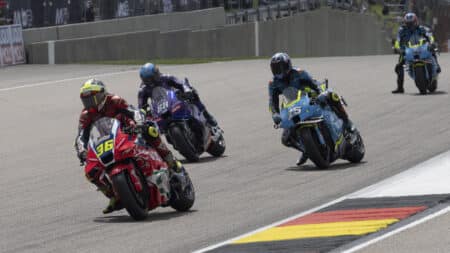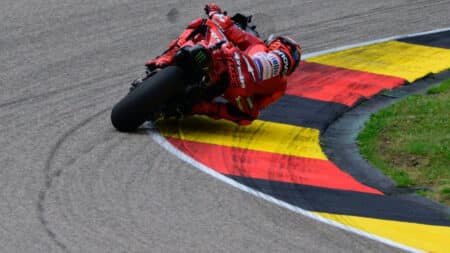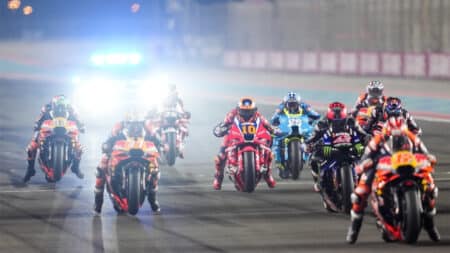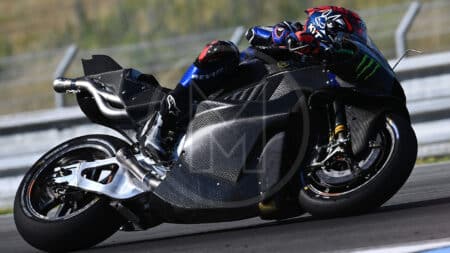Our fourth and final Hall of Fame blog looks at Oxley’s own top-three all-time greats

It is a foolish and impossible task, of course, but that’s no reason not to attempt it, right? So let’s start that daftest of pub debates once again: who is the greatest motorcycle racer of all time and who runs him closest?
I’ve absent-mindedly run this debate through my head for thirty years or more. During that time my podium of greatness has changed as I came to better understand the achievements of the greats, their performances according to the motorcycles they had beneath them and the rivals they had beside them, because merely counting race wins and world championships is never enough.
So, here we go, my all-time podium of greatness (in alphabetical order): Mike Hailwood, King Kenny Roberts and Valentino Rossi.
Who was the most talented? Impossible to know because these three men rode in different eras on different bikes, with different rivals and when different talents mattered. But it is still worthwhile wondering who was the greatest, so please indulge me as I try to imagine Hailwood, Roberts and Rossi lining up on the grid, getting ready to do battle, sometime around now.
Like all great racing champions, the Briton, the Italian and the American share many attributes: talent, determination and bravery for starters. They also started young.

Surprisingly, Hailwood started in earnest at a younger age than the others, even though the motorcycle industry had yet to invent the minibike when he was a kid. Back then, most racers found their love for bikes on the road and only hit the racetrack later. Hailwood’s luck was that his father, Stan ‘The Wallet’ Hailwood, owned a string of motorcycle shops and gave his son a handmade minibike when he was seven. Roberts was twelve when he stopped training horses and started riding bikes. Rossi raced karts before switching to minimoto when he was ten, mostly because his dad couldn’t afford to finance his karting career.
Hailwood went on to win 76 GP victories and nine world titles across four classes (125, 250, 350 and 500cc), Roberts won 24 GPs across two classes (250 and 500) and a 500 title hat-trick and Rossi is currently on 112 wins and nine titles across four classes (125, 250, 500 and MotoGP).
Hailwood raced at a time of relatively low chassis technology, when one tyre might last several races and the only suspension adjustment was a few clicks of preload on the rear shocks. He was proudly technophobic and it didn’t really matter that he didn’t know one end of a crankshaft from the other. His main talent seemed to be the ability to climb aboard any motorcycle and immediately take it to the edge.
“If you cobbled something together and gave it to him he would wring its neck right away without thinking about it,” said his Honda team-mate Ralph Bryans. “Most riders want the bike to be right before you can do your best, but Mike didn’t seem to bother that much.”
Bryans also said Hailwood “gave no feedback whatsoever” to his engineers but that didn’t stop him swapping bikes several times a day and winning on them all. Hailwood won GPs in three different classes at the same event on no less than six occasions during his career!

Does that make him the greatest? Possibly, but possibly not because racing had changed by the time Roberts and Rossi arrived. Roberts briefly raced a 250 alongside his 500 and Rossi briefly considered racing Moto2 and MotoGP.
As bikes get better, power increases, chassis work better and tyres grip more. This doesn’t make the bikes easier to ride, it makes them less problematic but increasingly physically, mentally and technically demanding. The greater forces involved require more strength and better fitness, which wouldn’t have pleased Hailwood, a man who felt happier in a bar than in a gym.
More technology also requires riders to spend more time in the pits, which means endless hours discussing squiggly lines on computer monitors with their engineers. If Hailwood was around now he would howl with horror at the hours Rossi spends in the pits. In his day the attitude was if it ain’t broke don’t fix it and let’s get down the pub. That didn’t work in Roberts’ era and it doesn’t work now: the quest is always for the next hundredth of a second.
Roberts came to Europe in 1978 as a relative novice in road racing. He wasn’t even a factory rider. He was a Yamaha US rider who had been given only one bike by Yamaha, while factory riders Johnny Cecotto and Takazumi Katayama had two each. It wasn’t until round seven of eleven that the Japanese realised they might have put their money on the wrong men and gave him another bike.

Hailwood spent his entire motorcycling career racing around deadly street circuits. Incredibly, street circuits were still on the GP calendar when Roberts arrived. Some fans suggest (idiotically) that Roberts didn’t have the balls to race the roads, but he could do it if he had to. In his rookie GP year he raced the deadly nine-mile Spa-Francorchamps street circuit and finished second, beating Barry Sheene and averaging over 130mph, in the wet.
“I was scared to death,” he recalls. “I didn’t know where I was going, couldn’t see nothing. I was racing with Sheene, thinking ‘this is so stupid’. The only reason I beat him was because he was more scared than I was. One time I was off the racetrack and sideways up against a wall, doing 130. I got it straight, looked behind and Sheene’s eyes were massive.”
Roberts was a huge force in improving the lot of the bike racer: track safety, paddock conditions and money. That might not have much to do with racing talent, but the fact that he could campaign ferociously for his fellow riders while winning world titles says a lot for his capacity to make things happen on and off the racetrack. And he would’ve won more than three world titles if Yamaha hadn’t so badly lost their way between 1981 and 1983.
It’s worth adding that when Roberts rolled up for his second GP, at Jarama, Spain, in April 1978, the organisers wouldn’t even give him a start, because he hadn’t scored any points in the previous year’s championship. Dumb, or what?

“I was in their office and Kel [Carruthers, his crew chief and mentor] had to get me out of there because I was about ready to kill someone, I was ready to go home. I missed first practice, then they had a jury meeting and let me ride.”
By the time Rossi arrived in 1996 such brainlessness was unthinkable. His longevity – twenty seasons and counting – makes the other two look like part-timers, but in spite of increased pressure and demands and a much-expanded calendar, racing is in many ways much easier nowadays: it is safer, better organised and the world is fully geared up for those living the peripatetic racer’s lifestyle.
Rossi’s achievements are mostly unmatched, across any sport. It is simply very, very unusual for anyone to compete at the top of a sport for two decades and more. He may never surpass Giacomo Agostini’s all-time GP record of 122 victories, but his stats already outdo Ago in the only class that really matters: 500s and MotoGP.
Rossi bubbles over with talent, just like Hailwood and Roberts before him but the other thing that makes him unique is his mastery of reinvention. The man has ridden and won on everything: from 125 and 250 two-strokes to 500cc two-strokes and 800, 990 and 1000cc four-strokes. He started out when many pit-lane engineers were sure that traction control would never catch on in bike racing as it had in car racing. He now works in an environment where electronics govern how the rider rides the motorcycle more than anything else.

Like most talented riders, Rossi would rather race without rider aids. “When I tried the first traction-control system with Honda at the end of 2002 I went back into the pits and I say ‘fuck, noooo’, I mean with this system everybody can ride the bike. And that was with one per cent of what we have now!”
Rossi has seen a generation or two of riders come and go and now he is fighting with riders who were in nappies when he first rode a 125 GP bike in 1994. He has had to change his style a dozen times to deal with different bikes and different rivals.
For all these reasons, my imaginary Grand Prix of the all-time greats has Rossi crossing the finish line a few tenths ahead of Roberts, with Hailwood right behind them in third place. Rossi wins on account of his ability to master pretty much every situation, Roberts just gets the better of Hailwood thanks to his superior understanding of technology, a must in motor sport.
But I’m sure you don’t agree with me…












